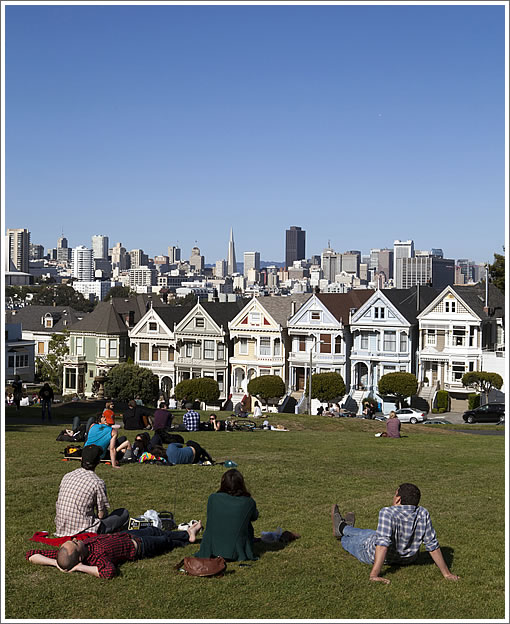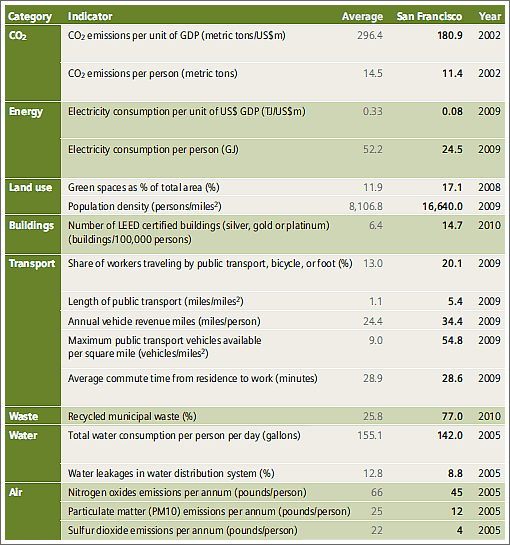
In a study commissioned by Siemens, San Francisco landed atop the “Green City Index” to be deemed the “greenest” major city in the U.S. and Canada.
The Index compared 27 cities on environmental performance and policies across nine categories: CO2 emissions, energy, land use, buildings, transport, water, waste, air quality and environmental governance.
San Francisco ranked first overall in the Index due to an impressive performance across the board, with a top five ranking in six of its nine categories. San Francisco’s strongest area is waste, where it led the pack with efforts such as being the first U.S. city to mandate composting and recycling for residents, food establishments and events in 2009. The city also claimed second place in buildings, transport and air, bolstered by strong green building and energy efficiency building standards, the second longest public transport network, and low levels of all pollutants measured in the Index.

“San Francisco’s sustainability programs deliver on multiple levels simultaneously,” said Environment Director Melanie Nutter. “They need to be good for the environment, but in order to have community-wide impact, they also have to address the economic needs of individuals, improve the local economy, and reverse social inequalities. You can see that commitment in play from our recycling and toxics reduction programs to our all-out effort to shut down gas-burning power plants operating within city limits.”
New York, Seattle, Denver and Boston rounded out the top five U.S. cities.
In terms of Land Use, however, San Francisco ranked 8th with a score of 66.6 versus 93.0 for New York City and just above Charlotte at 64.6 and Miami at 59.2.
Can you say density?
∙ US and Canada Green City Index [siemens.com]
∙ Study: US and Canada Green City Index [siemens.com]
∙ Presentation of the final results, Economist Intelligence Unit [siemens.com]
∙ Potrero Hill’s “Mirant” Power Plant Finally To Close January First [SocketSite]
∙ The Next Era In San Francisco’s Development: It’s All About Density [SocketSite]
Hurray for SF!
Odd choice of cities though. The study omits five USA cities larger than SF and includes several smaller.
There is an interesting green (money) trail to follow. Recology (formerly known as Norcal Waste Systems) is finding there is a good market for green waste. So much so that they purchased Grover Environmental Products last year. Grover operates two large facilities in the Central Valley that produce mulches and compost from the municipal green waste stream. Some of this is in turn used by organic farmers in the region or sold under their WonderGrow brand. They are also buiding a processing unit on site at EBMUD, so that they can sell much of their food scraps to EBMUD for use in their anaerobic digesters, which produce methane. The methane is then burned to generate electricity. The last article I read said the EBMUD should become a net producer of electricity some time this year. Not bad for a company with a no-bid, no-franchise-fee garbage concession, in perpetuity.
http://www.nytimes.com/2011/06/10/us/10bcstevens.html
I also applaud the efforts of SF!
biggest surprise on the list for me: LA was #7.
least surprise: Detroit was last.
I’d especially like SF to continue to increase the number of trees and also bikeways, but otherwise it’s done a great job for a city of its size and density.
Surprised that SF beat out Vancouver.
“biggest surprise on the list for me: LA was #7.”
That actually didn’t surprise me at all. LA, despite people’s protestations to the contrary, has some of the lowest energy usage per capita, despite being very car-based. I think the climate has something to do with it, but there are other things. The recycling/composting is far better here, although maybe it’s done on the back-end there rather than the front-end, but LADWP has better green initiatives than PG&E and the hotch potch of local water agencies here. Policy-wise, they are pretty strong down there too, and air quality is taken seriously — for example, I thought my buddy said that wood burning fireplaces can’t be added to houses. I’ll probably get my resident card stripped from me for saying it, but they occasionally do a few things right down there.
Odd choice of cities though. The study omits five USA cities larger than SF and includes several smaller.
What were you hoping to have on the list? What were you disappointed by seeing? It depends on which list:
Cities (not metro areas):
http://www.infoplease.com/ipa/A0763098.html
I’m assuming they didn’t use this list, because otherwise you have to include El Paso, Jacksonville, Nashville, and Milwaukee.
Metro areas:
http://en.wikipedia.org/wiki/Table_of_United_States_Metropolitan_Statistical_Areas
It looks like they picked most of the top 33 metro areas, but excluded a few based on proxies — e.g. Riverside and San Diego were covered by LA, San Jose by SF, San Antonio by two other Texas cities, Baltimore by DC, Cincinnati and Columbus by Cleveland, Orlando instead of Tampa, Seattle only without Portland, and maybe Phoenix for Vegas as a desert town. Maybe the data was easier to find for certain cities?
Also, St. Louis sat in for KC. That’s 11.
All well and good, but it would nice if the streets weren’t so dirty.
@sfrenegade, what stood out to me was your wikipedia metropolitan areas link. Dallas, Houston and Atlanta all gained over 1 million people in the last ten years! I find this astonishing in that San Franciscan’s constantly enjoy telling eachother how people are flocking to dense urban centers and giving up their cars, when according to wikipedia, they are flocking to sprawling heavy car use areas that are the exact opposite of San Francisco. (Of course, since they are including the entire Bay Area as one metro area, we have a large sprawling area of suburban neighborhoods and office parks as well.)
We are also number # 1 in flannel. >:p
How much of a benefit do we get due to our climate and the low number of heating degree/days we have? It’s hard to have low CO2 emissions in, say, Minneapolis, when you burn through $300 worth of natural gas a month just to keep the house at 63.
How much did the LEED certifications count toward the ranking? 14 vs 8 buildings per 100,000 people seems significant if you take 14/8, but 14/100,000 compared to 8/100,000 is fairly meaningless.
We’re also number one in overpaid government employees, most aggressive meter maids, most defecators per block in a single neighborhood (the ‘loin) and most dinner parties ruined by guests screeching about how much they hate Sarah Palin.
My dinner guests never play the Palin card, but on every other point you are spot on. Quality of life in the city varies greatly by neighborhood, and much of our environmental speak is noise.
Number 1…aha….um…..Not bad for the 4th most expensive U.S. city in the nation to live in…..keep paying those fees and taxes…Green…green…green
http://realestate.msn.com/article.aspx?cp-documentid=22130687
“@sfrenegade, what stood out to me was your wikipedia metropolitan areas link. Dallas, Houston and Atlanta all gained over 1 million people in the last ten years! I find this astonishing in that San Franciscan’s constantly enjoy telling eachother how people are flocking to dense urban centers and giving up their cars, when according to wikipedia, they are flocking to sprawling heavy car use areas that are the exact opposite of San Francisco. ”
Meanwhile, San Francisco has maybe 30K more people than it did in 1950, despite having many more housing units. Urbanists should definitely not be looking at Census data when they try to characterize America’s urbanization. I don’t know the 2010 definition because I haven’t looked through that much 2010 Census data yet, but look at the 2000 definition where towns of 2500 count as “urban clusters”:
http://www.census.gov/geo/www/tiger/glossary.html#urbanandrural
If you spend time in the “urban” areas, according to the Census Bureau, of other cities, outside of proper downtowns, it’s mostly suburbs. Even if you live within city limits, it still looks pretty suburban.
That said, some downtown areas of certain cities have become more popular destinations than they used to be. A good example is downtown LA.
sfrenegade – I wasn’t disappointed by any omission, just befuddled by their methodology. I doubt that adding any city left out would dethrone SF anyways unless the definition of “city” extends to some of the more granola intensive towns back east.
From reading the report I don’t believe that San Jose or any other bay area city was included in their analysis for SF. Just the 7×7.
I wonder how many points SF received for its unique curbside Humanure system. Very green … or perhaps I should say brown.
Do you run that program, diemos? You’d be good at it.
Such cynicism! San Francisco was expensive before sustainability became an issue, and many related efforts save money in the long term while contributing to resilience. Brittle and stinky is supposed to be a better way because of imagined savings. Tell that to future generations that inherit the charred cinder of the earth we leave behind.
Did I wander into the sfgate comments section by mistake? I don’t usually see so much cliched city-hating here.
@ataprice- since the cost of living is higher in Los Angeles than San Francisco, we are a “bargain” for “green” living.
On a serious note, I also think the moderate climate of the Bay Area plays a factor in usage rates vs. other locations. Does a city like Chicago, which is really making an effort at being green, get bumped down because of energy usage required for home heating?
^The climate certainly has a huge affect. However, many of the things measured in the study happen to be things that SF is notably ahead in (even far ahead of Chicago) – specifically recycling and composting. Chicago has concentrated primarily on buildings, which has a longer tail.
SF benefits from having farmers close by who will pay a lot for good compost, hence part of the reason that we’re able to divert so much of our trash (several times the amount of cities like Chicago and NYC). Composting is really extremely undervalued by most when talking about “green” policies, and recycling is typically oversold.
Every piece of human poop you see on the sidewalk saved ~1.6 gallons of water.
From reading the report I don’t believe that San Jose or any other bay area city was included in their analysis for SF. Just the 7×7.
San Jose MSA is a separate MSA. I wasn’t implying that SF included SJ, but rather that SF would be a proxy for San Jose.
However, the analysis for SF includes a mix of statistics for both 7×7 + SF MSA, as quoted from the report and as visible there (look in the bottom left-hand corner and some stats are city and some are MSA):
“Data included in the Index come from a mix of statistics for the city and metropolitan area, which has a population of 4.3 million.”
Lordy, what a mixed bag of data that was used to characterize SF. Odd to select the SF MSA since that’s just half of the bay area.
I imagine that the LA analysis is even more fraught with arbitrary and inconsistent delineation.
It is kind of surprising how well Houston fared. Aside from the core city that place seems to be a black hole for energy. Just the power consumed to condense humidity from the air is staggering.
“I imagine that the LA analysis is even more fraught with arbitrary and inconsistent delineation.”
It might be a combination of LA City and LA MSA. LA MSA is LA County and Orange County only. It doesn’t include Riverside MSA (Riverside/San Bernardino) or Oxnard MSA (Ventura), unless someone explicitly gives you LA CSA. I’m not sure how that would change the results, but I thought San Bernardino was supposed to have some of the worst air quality in California besides Bakersfield.